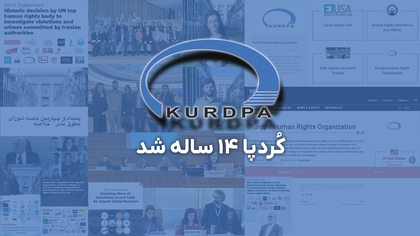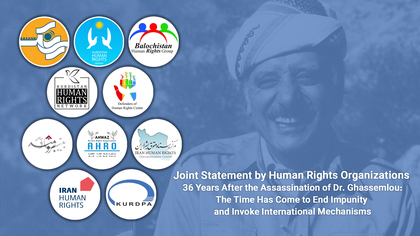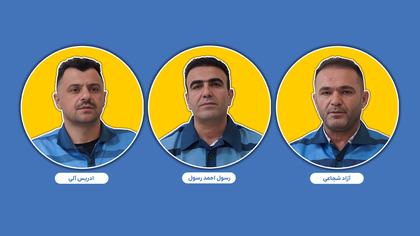Blaming U.S. and Israel, Iran Reports Killing of Nuclear Scientist
19:30 - 11 January 2012

Kurdpa — At a time of growing tension over its nuclear program and mounting belligerence toward the West, Iran reported on Wednesday that an Iranian nuclear scientist died in what was termed a “terrorist bomb blast” in northern Tehran when an unidentified motorcyclist attached a magnetic explosive device to his car.
It was the fourth such killing reported in two years and, as after the previous attacks, Iranian officials indicated that they believed the United States and Israel were responsible. News photographs from the scene in northern Tehran showed a car draped in a pale blue tarp being lifted onto a truck. A driver who acted as a bodyguard was also killed, news reports said.
The scientist was identified as Mostafa Ahmadi Roshan, 32, a professor at Tehran’s technical university, and a department supervisor at the Natanz uranium enrichment facility — one of two known sites where Western leaders suspect Iranian scientists are advancing toward the creation of a nuclear weapon.
Iran says its nuclear program is for peaceful purposes, but is facing a growing battery of international sanctions designed to force it to halt its enrichment program and negotiate with the West. On Jan. 23, European Union foreign ministers are to discuss a possible oil export embargo, adding further pressure.
Despite those pressures, Iran’s Atomic Energy Organization said it would not be diverted from its pursuit of nuclear technology. “America and Israel’s heinous act will not change the course of the Iranian nation,” it said in a statement quoted by Reuters.
The semi-official Fars news agency, which has close links to the powerful Revolutionary Guards Corps, said on Wednesday the reported bombing resembled the methods used in attacks in November 2010 against two other nuclear specialists — Majid Shariari, who was killed, and Ferydoun Abbasi, who was wounded and is now the head of Iran’s Atomic Energy Organization.
Almost exactly two years ago in January 2010, a physics professor, Massoud Ali Mohammadi, was also assassinated in Tehran.
Iran blamed the attacks in 2010 on Israel and the United States and the latest killing is bound to deepen an embattled mood in Tehran as the country’s divided leaders approach parliamentary elections in March. The latest bombing seemed likely to inspire similar accusations and news of the blast emerged quickly on Iran’s state-run media.
“The bomb was a magnetic one and the same as the ones previously used for the assassination of the scientists and is the work of the Zionists,” Fars quoted Tehran’s deputy governor, Safarali Baratloo, as saying, according to Reuters, reflecting a suspicion that the West and its allies were waging covert war.
Theodore Karasik, a security expert at the Institute for Near East and Gulf Military Analysis in Dubai, said the assassination fitted a pattern over the past two years of covert operations by the West and its allies to “degrade and delay” Iran’s nuclear program.
In a telephone interview, he said other elements of the Western campaign included the deployment of a computer virus known as Stuxnet and the sale of doctored computer software to hamper the enrichment program.
He said magnetic bombs were used in covert operations, describing them as “clean, easy and efficient.”
In recent days, several events have combined to create the deepest tension with the United States since the Islamic revolution in 1979 and the subsequent seizure of hostages at the American Embassy in Tehran.
Last weekend, Iran’s top nuclear official said the country was about to start production at its second major uranium enrichment site, in a defiant declaration that its nuclear program would continue despite the sanctions.
The announcement came two months after the International Atomic Energy Agency, the United Nations nuclear oversight body based in Vienna, published a report in November that Iranian scientists had engaged in secret and possibly continuing efforts to construct a nuclear weapon.
The imminent opening of the site — the Fordo plant, near the city of Qum — confronted the United States and its allies with difficult choices about how far to go to limit Iran’s nuclear abilities. The new facility is buried deep underground on a well-defended military site and is considered far more resistant to airstrikes than the existing enrichment site at Natanz, limiting what Israeli officials, in particular, consider an important deterrent to Iran’s nuclear aims.
On Monday, Iran announced that Amir Mirzaei Hekmati, a former United States Marine from Flint, Mich., had been convicted of spying for the C.I.A. and sentenced to death. He was arrested last August while he was visiting Iran for the first time.
His family, traumatized by the news, has asserted Mr. Hekmati’s innocence, saying he was visiting relatives, and has characterized the prosecution as a grave misunderstanding.
Mr. Hekmati served in the Marines for four years, spent five months in Iraq and took linguistics training in Arabic at the Defense Language Institute in Monterey, Calif. He was carrying his former military identification with him when arrested in Iran — atypical behavior for a spy.
Nonetheless, Iranian investigators may have been intrigued by Mr. Hekmati’s post-military linguistics work. In 2006, he started his own company, Lucid Linguistics, doing document translation that specialized in Arabic, Persian and “military-related matters,” according its Web site. “Our main goal is to assist organizations whose focus is on the current Global War on Terrorism and who are working to bridge the language barrier for our armed forces in Iraq and Afghanistan,” the site said.
Possibly more intriguing to the Iranians was work done a few years later by Mr. Hekmati while working for Kuma Games, which specializes in recreating military confrontations that enable players to participate in games based on real events.
A Pentagon language-training contract won in 2009 by Kuma Games, a New York-based company that develops reality-based war games — including one called “Assault on Iran” — lists Mr. Hekmati as a main contact.
That $95,920 contract, and Mr. Hekmati’s military background, his Iranian heritage and some linguistics work he did for the Defense Advanced Research Projects Agency, help explain why the authorities in Iran had him arrested.
At the same time, Iran has intensified belligerency to the naval activities of the American Fifth Fleet in the Persian Gulf and has threatened to block the Strait of Hormuz, a vital oil shipping route.
The United States Navy has responded with two well-publicized sea rescues in the area within a week.
On Tuesday, a vessel on patrol with the Navy’s Fifth Fleet near the Persian Gulf saved a group of distressed Iranian mariners, pulling them to safety from a cargo dhow that was foundering with a flooded engine room, the naval central command reported.
In a statement, the command said the Coast Guard patrol boat Monomoy, on assignment with a Fifth Fleet task force in the northern Arabian Gulf, approached the stricken Iranian dhow, the Ya-Hussayn, after the dhow’s crew hailed the Monomoy with flares and flashlights before dawn.
Last Friday, the aircraft carrier John C. Stennis broke up a high-seas pirate attack on a cargo ship in the Gulf of Oman. Sailors from an American destroyer boarded the pirates’ mother ship and freed 13 Iranian hostages who had been held captive there for more than a month.
Source – The New York Times
It was the fourth such killing reported in two years and, as after the previous attacks, Iranian officials indicated that they believed the United States and Israel were responsible. News photographs from the scene in northern Tehran showed a car draped in a pale blue tarp being lifted onto a truck. A driver who acted as a bodyguard was also killed, news reports said.
The scientist was identified as Mostafa Ahmadi Roshan, 32, a professor at Tehran’s technical university, and a department supervisor at the Natanz uranium enrichment facility — one of two known sites where Western leaders suspect Iranian scientists are advancing toward the creation of a nuclear weapon.
Iran says its nuclear program is for peaceful purposes, but is facing a growing battery of international sanctions designed to force it to halt its enrichment program and negotiate with the West. On Jan. 23, European Union foreign ministers are to discuss a possible oil export embargo, adding further pressure.
Despite those pressures, Iran’s Atomic Energy Organization said it would not be diverted from its pursuit of nuclear technology. “America and Israel’s heinous act will not change the course of the Iranian nation,” it said in a statement quoted by Reuters.
The semi-official Fars news agency, which has close links to the powerful Revolutionary Guards Corps, said on Wednesday the reported bombing resembled the methods used in attacks in November 2010 against two other nuclear specialists — Majid Shariari, who was killed, and Ferydoun Abbasi, who was wounded and is now the head of Iran’s Atomic Energy Organization.
Almost exactly two years ago in January 2010, a physics professor, Massoud Ali Mohammadi, was also assassinated in Tehran.
Iran blamed the attacks in 2010 on Israel and the United States and the latest killing is bound to deepen an embattled mood in Tehran as the country’s divided leaders approach parliamentary elections in March. The latest bombing seemed likely to inspire similar accusations and news of the blast emerged quickly on Iran’s state-run media.
“The bomb was a magnetic one and the same as the ones previously used for the assassination of the scientists and is the work of the Zionists,” Fars quoted Tehran’s deputy governor, Safarali Baratloo, as saying, according to Reuters, reflecting a suspicion that the West and its allies were waging covert war.
Theodore Karasik, a security expert at the Institute for Near East and Gulf Military Analysis in Dubai, said the assassination fitted a pattern over the past two years of covert operations by the West and its allies to “degrade and delay” Iran’s nuclear program.
In a telephone interview, he said other elements of the Western campaign included the deployment of a computer virus known as Stuxnet and the sale of doctored computer software to hamper the enrichment program.
He said magnetic bombs were used in covert operations, describing them as “clean, easy and efficient.”
In recent days, several events have combined to create the deepest tension with the United States since the Islamic revolution in 1979 and the subsequent seizure of hostages at the American Embassy in Tehran.
Last weekend, Iran’s top nuclear official said the country was about to start production at its second major uranium enrichment site, in a defiant declaration that its nuclear program would continue despite the sanctions.
The announcement came two months after the International Atomic Energy Agency, the United Nations nuclear oversight body based in Vienna, published a report in November that Iranian scientists had engaged in secret and possibly continuing efforts to construct a nuclear weapon.
The imminent opening of the site — the Fordo plant, near the city of Qum — confronted the United States and its allies with difficult choices about how far to go to limit Iran’s nuclear abilities. The new facility is buried deep underground on a well-defended military site and is considered far more resistant to airstrikes than the existing enrichment site at Natanz, limiting what Israeli officials, in particular, consider an important deterrent to Iran’s nuclear aims.
On Monday, Iran announced that Amir Mirzaei Hekmati, a former United States Marine from Flint, Mich., had been convicted of spying for the C.I.A. and sentenced to death. He was arrested last August while he was visiting Iran for the first time.
His family, traumatized by the news, has asserted Mr. Hekmati’s innocence, saying he was visiting relatives, and has characterized the prosecution as a grave misunderstanding.
Mr. Hekmati served in the Marines for four years, spent five months in Iraq and took linguistics training in Arabic at the Defense Language Institute in Monterey, Calif. He was carrying his former military identification with him when arrested in Iran — atypical behavior for a spy.
Nonetheless, Iranian investigators may have been intrigued by Mr. Hekmati’s post-military linguistics work. In 2006, he started his own company, Lucid Linguistics, doing document translation that specialized in Arabic, Persian and “military-related matters,” according its Web site. “Our main goal is to assist organizations whose focus is on the current Global War on Terrorism and who are working to bridge the language barrier for our armed forces in Iraq and Afghanistan,” the site said.
Possibly more intriguing to the Iranians was work done a few years later by Mr. Hekmati while working for Kuma Games, which specializes in recreating military confrontations that enable players to participate in games based on real events.
A Pentagon language-training contract won in 2009 by Kuma Games, a New York-based company that develops reality-based war games — including one called “Assault on Iran” — lists Mr. Hekmati as a main contact.
That $95,920 contract, and Mr. Hekmati’s military background, his Iranian heritage and some linguistics work he did for the Defense Advanced Research Projects Agency, help explain why the authorities in Iran had him arrested.
At the same time, Iran has intensified belligerency to the naval activities of the American Fifth Fleet in the Persian Gulf and has threatened to block the Strait of Hormuz, a vital oil shipping route.
The United States Navy has responded with two well-publicized sea rescues in the area within a week.
On Tuesday, a vessel on patrol with the Navy’s Fifth Fleet near the Persian Gulf saved a group of distressed Iranian mariners, pulling them to safety from a cargo dhow that was foundering with a flooded engine room, the naval central command reported.
In a statement, the command said the Coast Guard patrol boat Monomoy, on assignment with a Fifth Fleet task force in the northern Arabian Gulf, approached the stricken Iranian dhow, the Ya-Hussayn, after the dhow’s crew hailed the Monomoy with flares and flashlights before dawn.
Last Friday, the aircraft carrier John C. Stennis broke up a high-seas pirate attack on a cargo ship in the Gulf of Oman. Sailors from an American destroyer boarded the pirates’ mother ship and freed 13 Iranian hostages who had been held captive there for more than a month.
Source – The New York Times



